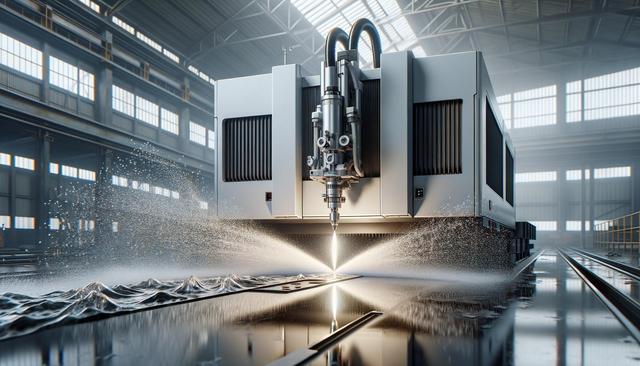Understanding Waterjet Cutting Technology
Waterjet Cutting Machines: Precision Cutting for Industrial Applications rely on a powerful stream of water, often mixed with abrasive materials like garnet, to perform accurate and clean cuts. The technology operates by forcing water through a narrow nozzle at extremely high pressures, often exceeding 60,000 psi. This stream can cut through a diverse range of materials without generating heat, which is a critical benefit in many industrial settings. The cold-cutting feature ensures that the material being worked on does not experience thermal stress, making waterjet cutting suitable for heat-sensitive materials such as composites, rubber, and certain metals.
There are two main types of waterjet cutting systems:
- Pure waterjet cutting: Best suited for softer materials like foam, textiles, and rubber.
- Abrasive waterjet cutting: Designed to cut harder materials such as metals, ceramics, and stone.
Each system is chosen based on the material properties and the required precision, making Waterjet Cutting Machines: Precision Cutting for Industrial Applications a versatile solution across multiple sectors.
Industrial Applications Across Diverse Sectors
Waterjet Cutting Machines: Precision Cutting for Industrial Applications are widely used in industries that demand high accuracy and material integrity. The aerospace sector, for instance, utilizes waterjets to cut aluminum, titanium, and composite parts without compromising structural strength. Similarly, the automotive industry benefits from waterjet cutting for trimming interior components and shaping metal parts.
Other industries include:
- Architecture and construction: Cutting stone, tile, and glass without cracking or warping.
- Electronics: Manufacturing components with intricate designs and tight tolerances.
- Food processing: Using pure waterjets to cut food products cleanly and hygienically.
The adaptability of Waterjet Cutting Machines: Precision Cutting for Industrial Applications makes them an essential tool for manufacturers seeking to maintain high standards of precision across different materials and design complexities.
Advantages Over Traditional Cutting Methods
One of the primary advantages of Waterjet Cutting Machines: Precision Cutting for Industrial Applications is the elimination of heat-affected zones (HAZ). Unlike laser or plasma cutting, waterjet systems do not introduce thermal stress, which can alter the physical properties of the material. This leads to cleaner edges and reduces the need for secondary finishing processes.
Additional benefits include:
- Minimal material waste due to narrow cuts (kerf width).
- Environmentally friendly process with no hazardous fumes or gases.
- Capability to cut multi-layered materials and composites.
These features contribute to higher efficiency and cost-effectiveness in the long run, especially when dealing with high-value materials or intricate designs.
Key Components and System Configuration
To understand the performance of Waterjet Cutting Machines: Precision Cutting for Industrial Applications, it’s important to consider the core components that make up the system. These include the high-pressure pump, cutting head, abrasive delivery system, and control software. Each element plays a crucial role in delivering precision and reliability.
Key components explained:
- High-pressure pump: Generates the necessary pressure to propel water through the nozzle.
- Cutting head: Where the high-pressure stream is focused, often equipped with a mixing chamber for abrasives.
- Abrasive delivery system: Feeds the abrasive material into the stream for cutting harder substances.
- Control software: Enables CNC automation for complex and consistent cutting patterns.
Advanced configurations may include multi-axis cutting heads, enabling 3D cutting and beveling, further expanding the capabilities of these machines in industrial environments.
Considerations for Implementation and Maintenance
For industries considering the adoption of Waterjet Cutting Machines: Precision Cutting for Industrial Applications, several factors need to be evaluated for effective implementation. These include the type of materials to be processed, required cutting tolerances, and production volume. Choosing the right system configuration and training operators adequately are also essential for maximizing performance.
Maintenance considerations include:
- Regular inspection and replacement of nozzles and orifices.
- Monitoring abrasive quality and flow rates.
- Keeping the pump and high-pressure lines clean and well-lubricated.
Proactive maintenance not only extends the life of the equipment but also ensures consistent cutting quality, making Waterjet Cutting Machines: Precision Cutting for Industrial Applications a dependable asset in the production workflow.
Conclusion: Precision and Versatility for Modern Industry
Waterjet Cutting Machines: Precision Cutting for Industrial Applications offer a compelling combination of accuracy, material versatility, and operational efficiency. Their ability to handle a wide variety of materials without causing thermal damage makes them especially valuable in industries that require high-performance cutting solutions. For businesses aiming to enhance their fabrication capabilities while maintaining material integrity, waterjet technology presents a reliable and adaptable option that continues to evolve with industrial demands.




Leave a Reply